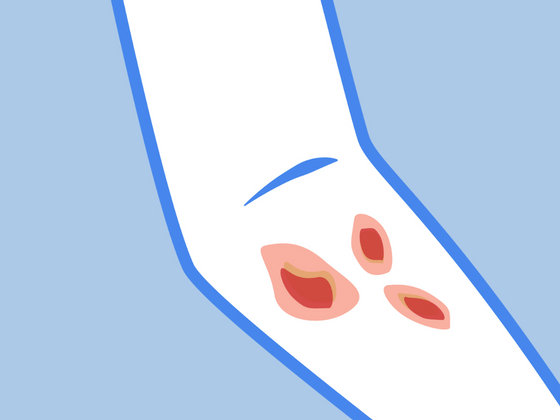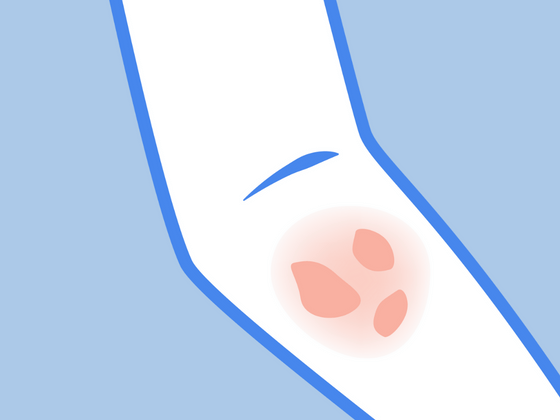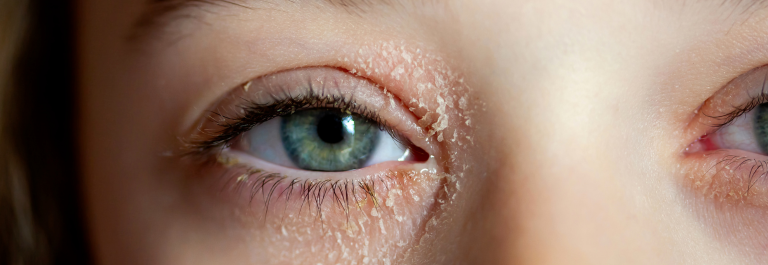Do you ever experience itchy or swollen eyelids? Although eyelid eczema, also known as eyelid dermatitis, can be caused by a variety of external or internal factors, most cases are characterized by several common symptoms including itching, stinging, and/or burning. It is also quite common to experience red, swollen, or flaky skin.
If you’re suffering from eyelid dermatitis, we’re here to help you heal your eczema naturally and safely.
Please keep in mind that although these treatments can relieve eczema, we are in no way medical professionals. If you’re experiencing severe eczema symptoms like fever or an infection, it is best to seek medical advice immediately.
Atopic Dermatitis vs. Atopic Contact Dermatitis vs. Irritant Contact Dermatitis
There are three types of eyelid dermatitis that are common in eczema patients, and we will discuss them in this post.
They are:
- Atopic dermatitis with eyelid involvement
- Allergic contact dermatitis and
- Irritant contact dermatitis.
However, there are many other causes of eyelid dermatitis including psoriasis, seborrheic dermatitis and other conditions. It is very important to see your doctor to get the right diagnosis before proceeding with treatment.
Allergic Contact Dermatitis (Most Common)
Allergic contact dermatitis is the most common cause of eyelid inflammation in atopic dermatitis patients.[1] Allergic contact dermatitis (ACD) is a type IV delayed-hypersensitivity reaction, which means that your immune system comes into contact with a foreign particle (an allergen) that triggers the immune system to react. ACD requires a re-exposure to the allergen/offending agent before symptoms are noted. The symptoms typically manifest hours to days after re-exposure.
If you are experiencing red, itchy eyelid, flaky skin or skin irritation due to topical exposure to poison ivy/oak, metals (cobalt, nickel), chromates (leather products), adhesives, sunscreens, fragrances, personal hygiene products, or pet dander, then allergic contact dermatitis may be the cause of your eyelid inflammation.
Irritant Contact Dermatitis
Irritant contact dermatitis occurs due to DIRECT injury to the skin. This injury does not involve T-lymphocytes and antibody formation as is seen in allergic contact dermatitis or atopic dermatitis. Irritant contact dermatitis occurs directly (minutes to hours) after exposure). It is rare for patients with eczema to have solely irritant contact dermatitis (<1%) [1].
Common causes of ICD include irritants such as chemicals, solvents, some adhesives and very hot or cold temperatures. The irritant can enter the eye area, cause friction and damage leading to temporary discomfort and redness.
If you can determine that neither of the above types of contact dermatitis relate to your flare up, then you likely have atopic dermatitis. This is an internal reaction expressed through the skin and often triggered by things like stress, consuming certain foods, seasonal or environmental allergies, etc.
Atopic Dermatitis with Eyelid Involvement
Atopic dermatitis is a multifactorial skin condition that is characterized by a leaky skin barrier, sensitization to allergens, altered skin microbiome, and inflammation. The cause of atopic dermatitis is currently thought to be both poly-genetic and environmental, and research is underway to better pinpoint which genes (e.g. filaggrin) and environmental factors contribute to its development. One area that may be affected by atopic dermatitis are the eyelids.
Although these types of dermatitis may be triggered differently, their symptoms are quite similar.
It’s best to get a physician’s diagnosis to properly diagnosis your skin condition just to be sure. Your eye area is very sensitive, and we don’t recommend taking any chances.
Symptoms of Eyelid Dermatitis
If you already suffer from eyelid dermatitis, then you probably already know the uncomfortable and annoying symptoms associated with the condition.
These include:
- Changes in eye appearance (i.e. an extra fold of skin above or under the eye, eyelids darken)
- Inflamed, red eyelids
- Scaly or flaking skin
- Itching
Although rare, those suffering from atopic eyelid eczema can also experience complications such as cataracts, spontaneous retinal detachment and eczema scars.
To best avoid these complications, it is always best to seek medical attention immediately, once symptoms are difficult to handle. It’s also important to make sure not to rub or scratch the area in order to avoid skin infections and eye problems as mentioned above.
Common Triggers for Eyelid Eczema
If you are suffering from eyelid eczema due to irritants, then your first step is asking yourself what might be the main cause of your eczema:
- Do my eyes itch or swell after I pet my dog, cat, etc? Your nose could also itch and drip.
- Do my eyes tear and/or itch when I use a certain type of mascara, eye shadow or eyeliner?
- Do my eyes change in appearance based on temperature?
- Have I gotten an insect bite on or near my eyelid recently?
If you are able to answer at least one of these questions, the first step is simple: AVOID THE TRIGGER.
For patients with pets where avoidance is not an option, one strategy is to keep pet dander/saliva away from the face and eyelids. Another strategy is to wash the hands immediately after direct contact or avoid direct contact. Keeping pets off the bed or sofa and anywhere you may rest your head is a good idea as well.
As stated prior, it’s important to avoid scratching your eyelids and periorbital areas. Scratching can introduce bacteria to the irritated skin leading to a superimposed infection. This can affect both the skin and the eye.
If you cannot identify an obvious source of your eczema, then your condition might need a little more care.
Non-Prescription Treatments for Eyelid Eczema
Eyelid Creams
There are thousands of eyelid creams that can be found in stores; however, many are made with unsafe, harsh ingredients including heavy metals and dyes.
Eyelids are the thinnest skin on your body (only ~0.5mm!) and are thus very sensitive. It is important to be careful about putting products on the eyelids to avoid further irritation.
Our editor’s favorite product for the eyes or face or anywhere on the body is the Nourish + Hydrate Manuka Balm. Keep in mind this is a creamy balm, so it’s very thick and rich. A little goes a long way. Some people who are used to light facial lotions may find this product too heavy.
If gentle and natural is what you are looking for, we recommend Calendula Eczema Cream for Face. This cream is both gentle and cooling, as it contains both Organic Calendula flowers and Organic Aloe juice. It contains Dimethylaminoethanol (DMAE), a natural supplement that has been shown to have potential anti-inflammatory, firming, and anti-aging in in murine skin [2,3]
To gently cleanse the eyes and face, be sure to check out this natural Organic Calendula Face Wash. Similar to the ingredients in the cream mentioned above, this face wash is gentle with its blend of soothing herbs and will help calm red, inflamed skin. It’s also an excellent face wash for extremely sensitive skin. The wash and cream work really well together.
Wet or Dry Wrap Therapy
If you’re experiencing extremely itchy and inflamed eczema, then you can always try adapting wet or dry wrap therapy for eczema around the eyes.
Both wet and dry wrap therapy are common processes used among eczema sufferers and can be used as a short-term fix for moderate to severe eczema. Instead of using body bands or clothing, feel free to use bandages or cut out strips of clothing to drape over the eyes.
A word of warning: DO NOT use corticosteroids or calcineurin inhibitors (Protopic is a common brand name) medication for this method unless instructed by a dermatologist. The eyelids are extremely sensitive, and you do not want to risk damaging your eyes.
Do you suffer from eyelid eczema? Let us know how you treat it in the comments below!
References:
- https://www.ncbi.nlm.nih.gov/pubmed/12399770
- https://www.ncbi.nlm.nih.gov/pubmed/20095140
- https://www.ncbi.nlm.nih.gov/pubmed/25133239








